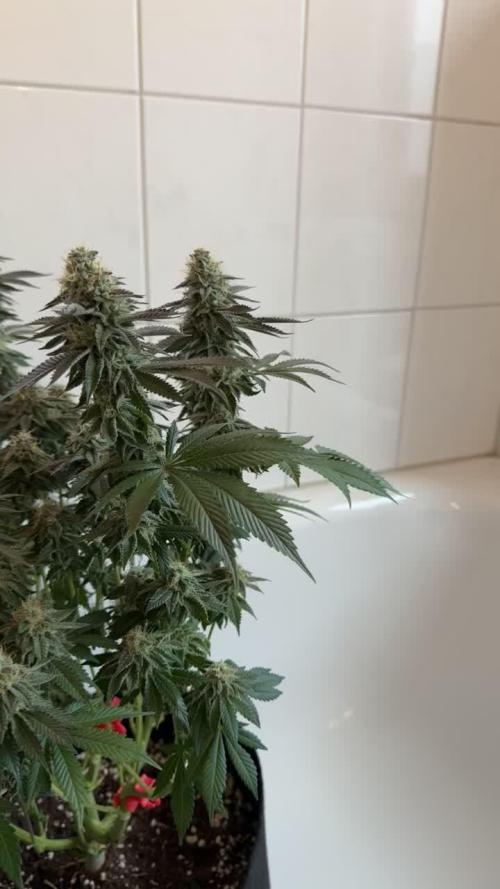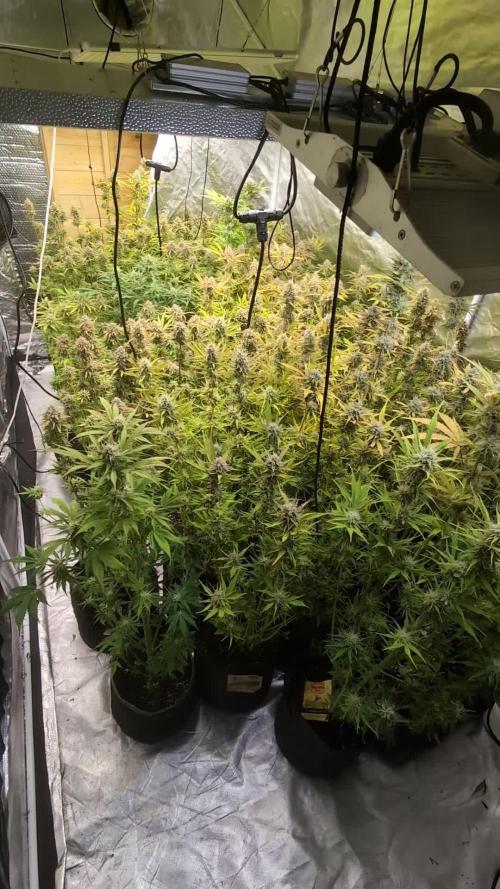The Grow Awards 2026 🏆 



























Likes
Comments
Share


@AsNoriu
Follow
Day 72 since seed touched soil. All is okeish in garden. AK is stacking well, has damage from slow release nutes and light burn. Nutes always do that shit for few waterings, plus stupid PH damage, which led to weaker plants and light burn....
you do one mistake and all chain of issues comes up ... its hard to grow in limited conditions ....
Mars TSL2000 is now on very healthy distance. Works fine.
Temps are in good range. Humidity spikes to 70 on watering day, but is in 60-65 during others.
Happy Growing !!!
Likes
4
Share


@FlowerForYou
Follow
20/06/24 (FD 22): Stretch is about done, the smaller skunk plant decided to overtake it's sister and measures now nearly 60cm!
I felt like the ladies really needed a haircut, so I gave them a nice one. Took off ~1/3 of the lower leaves + shoots and a bunch of upper fan leaves to bring down humidity & allow for a better air circulation!
Weather is still quite shit and it's hard to get dry air during the night time, I just hope I have a good enough ventilation system to prevent mold...
Also cranked up the mars hydro TS1000 to 100% and I hope buds will swell nicely from now on!
Likes
40
Share


@Peeman
Follow
Oct.7 day 68 buds are still stacking and getting harder every day & trichomes on all plants are now milky except for Trainwreck #2 which has turned into a long flowering sativa. Powdery mildew has gotten a little out of control on most of the potted girls so I started the long & tedious task of harvesting 1 plant per day starting with Blue Fire #1. Being a one-man operation I’m not looking forward to all the work that lies ahead however judging by the look and smell of these babies, should be well worth it in the end.
Oct.8 day 69 cut down all the main colas on Blue Fire #2 & Strawberry Banana #2. Giving the lower branches a few more days to finish then chop chop and into the freezer. 😜😁👌
Oct.10 day 71 cut down all the main colas on Godfather OG #2 and keeping the rest for fresh frozen water hash. Also started trimming Godfather OG #1 eight days after she was harvested. First time drying in the garage which is detached from the house and is not insulated. Average temps in there this week were low 50's-60's F and 55-70% humidity. My concern was temps being too low and the fluctuating humidity. So far after eight days of hang drying in the garage with 2 small fans lighty blowing directly on the colas, God father OG #1 was dry and ready for final trim. That worked out better than I hoped. 🙌
Oct.11 day 72 Trainwreck #2 got chopped whole and is hanging. I would normally trim it up quite a bit before hang drying but I need a break today.
Oct.12 day 73 Strawberry Banana #1 finally got chopped today. I shot a video of it in time lapse which compresses my five hour chop time to about one minute.
That concludes the harvest of all my outdoor girls this season. Stay tuned for more photos, final weights and reviews.
...till next time
Thanks for stopping by
See ya and stay safe
Likes
5
Share


@qoodwater
Follow
Hello, this week Uva light was added, 2 15w lamps are working 1 hour a day!
I have no idea of the results because it's the 1st time I use uv light and skywalkerhaze! But they are still beautiful and getting fat!
Thanks for Watch
Processing
Likes
10
Share


@Ch33cH
Follow
So WeedSeedsExpress was kind enough to supply me with there Auto-NL. A strain that always lands in the tent every few cycles as its one of my favourite classics.
I have grown out a few breeders strains of NL but never ran an Auto version of it so something new in it for myself.
a little video of the packing which i thought was quite cool in an old school style cut out booklet.
We are a week in, Sorry for lack of photos i ended up having a bit of a rush at time.
I germinated 5 and all 5 germed and sprouted but lost one due to an accident in the tent.
Just running on some plain water and superthrive for now.
These have grown perfectly fine.
Likes
6
Share


@Frutalba15
Follow
11. Woche und ihr geht es gut. Habe sie ein wenig entlaubt, damit auch die kleineren Blüten Licht abbekommen :) Dünger nimmt sie wieder super auf!
Likes
27
Share


@MaltaHerbman
Follow
Its time for more pk i am using Hesi phosphorus plus.
Plants look like love it.
Thank for watching lot of ❤️ from 🇲🇹
Likes
4
Share


@Exoticfarm99
Follow
Está semana regamos con agua un par de veces y quitamos un par de hojas satélites que tapaban cogollos
Likes
25
Share


@Targona
Follow
26 days since my little girl sprouted from a seed🌱
Third week of growing my Gorilla Cookies Auto 🦍🍪🦍
Nutrients:
I use Advanced Hydroponics Of Holland nutrients - three basic components, always according to the table for vegetative growth 💓 -
- Dutch Formula 1 Grow - supplies the plant with substances necessary for the perfect development of roots, stem and leaves; intended for the growth phase 🌾
- Dutch Formula 2 Bloom - contains a large amount of nutrients needed for rapid growth and development of fruits, provides energy to the plant; intended for the flower phase 🌸🌿
- Dutch Formula 3 Micro - increases oxygen intake, improves plant immunity, ensures better absorption of nutrients; intended for the growth and flowering phase 🌴
-------------------------------------------------- -------------------------------------------------- --------
BioBizz Calmag - The special Calmag supplement was designed for professional and hobby growers who need to supply calcium and magnesium in organic quality to plants for a long time or immediately. 100% organic 💩💩 and certified BioBizz Calmag product is made from calcium carbonate and magnesium sulfate supplemented with humic acid.
-------------------------------------------------- -------------------------------------------------- --------
BioBizz Bio pH- is an organic pH regulator. Aqueous solution of citric acid, which occurs naturally in citrus fruits 🍋🍋
-------------------------------------------------- -------------------------------------------------- -------
During the flowering period, I add Advanced Nutrients stimulators:
- Bud Ignitor (first two weeks of flowering) - flower stimulator 🌸🏵️
- Bud Candy - carbs for my girls 🍭🍭🍭
- JUNGLE - ENVIRON X is a highly effective complex product
stimulate the formation of flowers. Contains no synthetic growth regulators (PGRs).
• multiplies yield and increases product quality
In general:
Gorilla Cookies Auto 🦍🍪🦍 - The girl went into the flowering phase, so I adjusted the nutrients. She grew a lot in height, because she germinated 10 days later than the other girls in the tent. It responds very well to nutrients, is strong and has a beautiful green color 🍃💚
Training:
During this period, I usually do another defoliation and LST 💚🌞🌞
Light: Mars Hydro TS1000 The plants react effectively and the light is technically very well managed - I try to have 50cm between the light and the plants, so I move it up regularly 💡💡💡
See you soon 😍💚
Likes
15
Share


@Jan1512
Follow
Ich habe mich mal mit LST probiert. Habe es einfach mal aus dem Bauch heraus gemacht. Ist bestimmt nicht optimal aber es gibt ja immer Luft nach oben ;)
Likes
42
Share


@GanjaReaper
Follow
This week i only gave them 2 feedings, one only water and one with Enzym+ because last week I gave them lots of nutrients.
I did that because they asked for it and could take it but in the other hand it was really hot so alot of feeding got evaporated
which can result in a salty/old nutes medium.
So with that in mind i let the enzymen do their work(cleaning and re-using nutrients) while making sure that i lower the EC in my pots down again
because right now the weather this week is like 20-23 degrees with alot of rain, because of that, the plants don't drink up/evaporate that fast as they do when its hotter.
Meaning i can't give as much water as they used to, so the EC in the pots will stay higher.
A high EC is not a smart thing to have, plants will get a higher change of shutdowns, can even get diffiencies because of that.
And the last thing a grower wants to have is heavy pots for lots of days LOL.
ps, I should consider making 2 different buckets of feeding because my criticalkushes are still not showing signs of preflowering.
To be honnest i'm not completely happy about the critical kush strain because the breeder promised a 100% Indica strain, which in my opinion is not.
It is just another hybrid and a really slow one.
pss, I will lower my EC in the comming weeks because I want my buds to get bigger and in later stages I will raise my EC again to make them compact,smelly,tasty,frosty,
With high EC, you get compact,smelly,frosty,tasty but small buds, with low ec you get big but fluffy ones and not that frosty.
This doesn't count for Autoflowers since they need way less ec...
I did this many times with inside grows, we will see how it goes outside with these two strains.
Likes
Comments
Share


@smoking_hills9
Follow
These cali genetics are blowing my mind 🤯 super sticky, very frosty rock dence buds with extra strong smells. All 3 strains are 10 out of 10, very impressed. Done last defoliation few days ago, preparing for the harvest so it's much easier. Stalks are super fat, same as buds.
Got big surprise from Atami, plant food, and many extras. Crazy. Thanks a lot guys. 💚 Start adding you Bloombastic food already. They love it. Smell is mad. I think most of plants ready in week or so.
Likes
Comments
Share


@Olduffybastard88
Follow
Little video showing you around the garden at the start you can see the flowering phenos at the end youll see my vegging phenos waiting in line for space in thr flower tent
Likes
8
Share


@Kaia108
Follow
You can see the nute burn here from the first and only feeding earlier in the grow. Just a tad too much fertilizer.



































